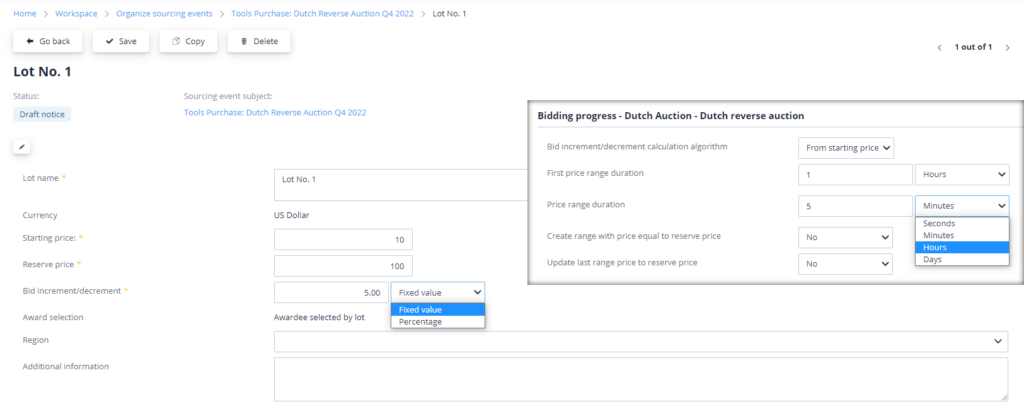Home » Notes & Thoughts » What is a Dutch Auction and why it should be an integral part of your e-sourcing strategy?

Dutch Reverse Auction is a form of sourcing event tailored to purchasing goods or services. A distinctive feature of the Dutch Auctions is the presence of bid increment intervals. The bid increment intervals and reserve price are determined by the purchaser. Firstly, the purchaser establishes the initial (starting) price of the item being procured, and then within a certain timeframe, the price increases for a specified amount that is determined by the purchaser.
Usually, the reserve price equals the average market price of the goods or services being procured, while the initial price – is the lowest (based on the estimation of the purchaser) price for which the suppliers may agree to provide their goods or services. As lower the price for which the suppliers would agree to execute supply than the average price on the market the better.
So, the key point of a Dutch Auction is finding a supplier that would agree to supply the goods or services at the lowest price below the average as it is possible. The supplier that first agrees to supply the goods or services at the lowest price would win the contest. The bidding process will automatically stop once the price reaches the reserve price level and no one agrees to provide a supply.
Let’s review an example: You decided to source Item X by conducting Dutch Reverse Auction with the following settings:
1. The initial price of Item X equals $10.
2. The bid increment equals $5.
3. The price range duration is 1 hour (So, every hour the price would be increased by $5).
4. The reserve price equals $100 (The maximum price at which you agree to buy Item X).
You have invited Supplier A, Supplier B, and Supplier C to the sourcing event. The bidding starts at $10, and the price for supplying item X increases by $5 every hour: $15, $20, $25, $30, $35, etc. The sourcing event will be completed once one of the suppliers agrees to supply Item X at the lowest possible price. If none of the suppliers agrees to execute the supply, the sourcing event will be completed without the awardee, once the price will reach $100 (since you set the reserve price at $100).
Let’s assume that Supplier A has first agreed to supply Item X at $35. In this case, Supplier A automatically wins the contest, while Supplier B and Supplier C lose.
The purchasing managers may use such a form of the sourcing event in order to receive the items at the best price and to find out what would be the lowest possible price for which the suppliers would be able to sell the particular item.

In Acquirell Dutch Reverse Auction is a form e-sourcing event that is held in the system via a web portal.

In the framework of this e-sourcing event, the buyer sets the initial price, the bid increment, the price range duration, and the reserve price. Then the buyer invites the suppliers to participate in the e-sourcing event. The supplier which first agrees to supply the item or service at the lowest price would win the event.

Consequently, the contract can be initiated with the awardee directly from the sourcing event. The system automatically completes the e-sourcing event once the first proposal is submitted. If none of the suppliers submits a proposal, the system will automatically complete the e-sourcing event by reaching the reserve price (the maximum price at which the organizer can purchase the item or service).
Fill out the form and the Acquirell team will provide a profile for you shortly to conduct the Dutch Reverse Auction and other types of sourcing events.
| Cookie | Duration | Description |
|---|---|---|
| cookielawinfo-checkbox-analytics | 11 months | This cookie is set by GDPR Cookie Consent plugin. The cookie is used to store the user consent for the cookies in the category "Analytics". |
| cookielawinfo-checkbox-functional | 11 months | The cookie is set by GDPR cookie consent to record the user consent for the cookies in the category "Functional". |
| cookielawinfo-checkbox-necessary | 11 months | This cookie is set by GDPR Cookie Consent plugin. The cookies is used to store the user consent for the cookies in the category "Necessary". |
| cookielawinfo-checkbox-others | 11 months | This cookie is set by GDPR Cookie Consent plugin. The cookie is used to store the user consent for the cookies in the category "Other. |
| cookielawinfo-checkbox-performance | 11 months | This cookie is set by GDPR Cookie Consent plugin. The cookie is used to store the user consent for the cookies in the category "Performance". |
| viewed_cookie_policy | 11 months | The cookie is set by the GDPR Cookie Consent plugin and is used to store whether or not user has consented to the use of cookies. It does not store any personal data. |